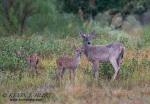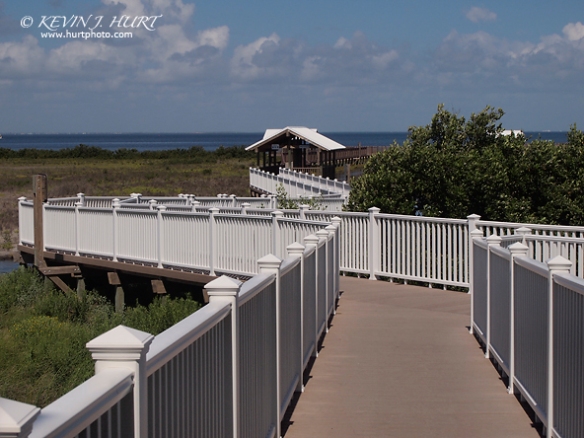Late spring to early summer ushers in a time of new beginnings for the white-tailed deer, a time when does are giving birth to their fawns all across the South Texas brush country. The first week of a young fawns life is the most perilous as they are ever vulnerable to predators such as coyotes, bobcats, and mountain lions. Although fawns are able to walk at birth, it is their ability to lay motionless for hours at a time that is often the difference between living and dying. Instinct tells these young fawns to curl their heads into their bodies, or to lay it stretched flat on the ground, making it harder for predators to see them.
 Nature has equipped the fawn for survival as they are born nearly odorless for the first few days of their life. Their spotted coats, which serve as a natural form of camouflage, blend in perfectly with the brush. During a fawn’s first three weeks, the does will leave their young alone for extended periods of time, returning only to nurse them and move them to another secluded area. Doing this reduces the amount of scent left by the doe and makes it more difficult for predators to determine exactly where the fawns are hiding. Interestingly, if a doe gives birth to multiple fawns, she will hide each of them in separate locations.
Nature has equipped the fawn for survival as they are born nearly odorless for the first few days of their life. Their spotted coats, which serve as a natural form of camouflage, blend in perfectly with the brush. During a fawn’s first three weeks, the does will leave their young alone for extended periods of time, returning only to nurse them and move them to another secluded area. Doing this reduces the amount of scent left by the doe and makes it more difficult for predators to determine exactly where the fawns are hiding. Interestingly, if a doe gives birth to multiple fawns, she will hide each of them in separate locations.
As the fawns grow and mature, they will begin to follow their mother, bonding and learning the way of life in the brush country. With greater strength in their legs, they are now faster, more agile, and able to evade predators. If you see a lone fawn, do not fear that it has been deserted. Momma is not far away. Take care not to touch a wild fawn; human scent on the young deer could cause a doe to abandon her young.
Getting Close Enough To Photograph A Fawn 
Unless you are very lucky or know where to go, getting a great photograph of a young fawn is difficult. If you know of a location where seeing does is a common occurrence, then you are likely to see a young fawn after its third week of life when it begins to cling to its mother’s side. Thus, to capture a great image of a fawn, try to attract the does with feed. To paraphrase a line from the movie “Field of Dreams”, if you bait it, they will come. In South Texas, where the deer are accustomed to being fed corn, simply keeping an area baited will assure that the does, and eventually their fawns, frequently visit the bait site. Try to isolate the fawns in your images, but remember to take a few with them by their mother’s side. Getting behavioral shots, e.g. nursing, jumping, playing, etc. requires a bit of anticipation on your part but if you pay attention, you will learn to anticipate the action and thus, be ready to capture it when it occurs. Photos of fawns juxtaposed with a buck, such as the one in this blog’s header, are rare; as bucks play no part in raising their fawns so if you are lucky enough to capture this image, know that you have a rare photograph.
Photography Essentials
 White-tailed deer are crepuscular animals, i.e. they are most active during twilight hours. So, to capture inspiring images of white-tailed fawns, you’ll need to be in the brush early in the morning or late in the evening when: a) they are most active, and b) the light is most pleasing. Speaking of light, you need to consider its direction and the time of day in which you plan on taking the photograph. Once you have determined whether to shoot in the morning or evening, setup a photo blind at the baited area and within the distance of your longest telephoto lens. Then, just patiently wait. I typically use a 500mm lens when photographing white-tailed fawns but on occasion have captured good images with a 70-200 + 1.4x extender on a crop factor camera body.
White-tailed deer are crepuscular animals, i.e. they are most active during twilight hours. So, to capture inspiring images of white-tailed fawns, you’ll need to be in the brush early in the morning or late in the evening when: a) they are most active, and b) the light is most pleasing. Speaking of light, you need to consider its direction and the time of day in which you plan on taking the photograph. Once you have determined whether to shoot in the morning or evening, setup a photo blind at the baited area and within the distance of your longest telephoto lens. Then, just patiently wait. I typically use a 500mm lens when photographing white-tailed fawns but on occasion have captured good images with a 70-200 + 1.4x extender on a crop factor camera body.
Recent Images
Near the end of August, my good friend, Hector Astorga, and I took a trip to the coast to photograph white-tailed fawns. At this time the fawns were about 2-3.5 months old and very active. We were up at 5:00 A.M. and in the brush by 6:45. As the sun started to come up on the eastern horizon, the fawns were evenly painted by its warm luminescence. Their spotted coats were a blazed in a deep, rich, reddish brown color. This was the magic hour of light and over the next 90 minutes, we proceeded to capture some truly spectacular images that I share below:

White-tail are curious animals so whistling as they walk away can often result in these beautiful, looking back over the shoulder poses.

Not all fawn pictures have to be frame filling. This is a classic picture that tells a story of the fawns survival in its environment.
 Seeing a white-tailed fawn in the wild is one of the most fascinating sights in nature. It’s also very rare. So if you happen to come across a fawn in the brush, briefly observe it and enjoy the moment. Until next time, remember to take your kids outdoors. –Kevin
Seeing a white-tailed fawn in the wild is one of the most fascinating sights in nature. It’s also very rare. So if you happen to come across a fawn in the brush, briefly observe it and enjoy the moment. Until next time, remember to take your kids outdoors. –Kevin



























